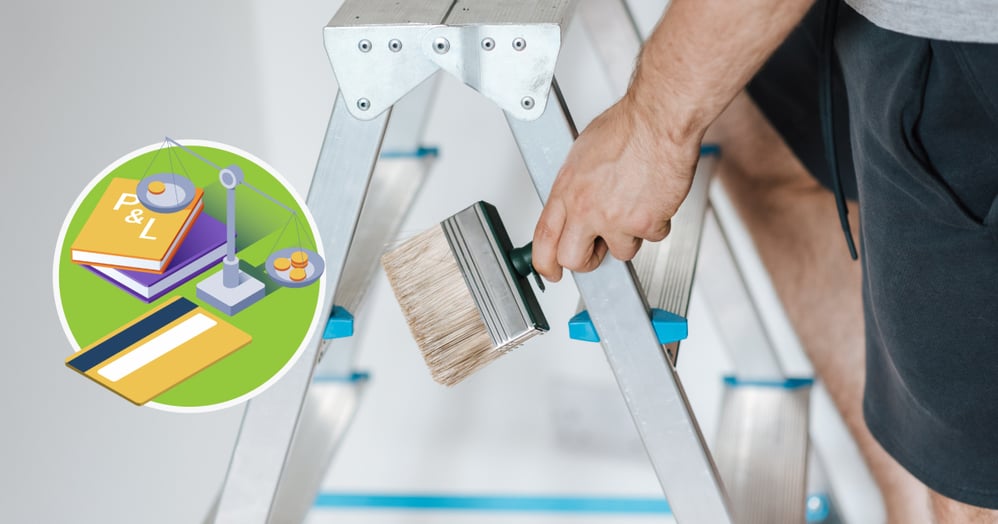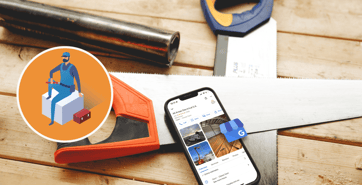Your Guide to Painting Business Start-Up Costs
by Team Tradify, April 28, 2023

Table of Contents
To get a new painting business up and running, you can expect to pay somewhere around $5,000 USD or £4,000. While this is a good figure to keep in mind, be aware that it will change depending on where you live, your personal situation and goals, marketing budget, insurance plans, and the tools and materials that are essential to the running of your business.
Before you start to put together a business plan, brainstorm a catchy business name, or think about hiring staff, it’s critical that you consider every cost possible.
Find your perfect hourly rate with our free Charge Out Rate Calculator!
Short on time? Skip ahead!
- 1. Tools
- 2. Stock & inventory
- 3. Insurance
- 4. Transport
- 5. Marketing & advertising
- 6. Making it official
- 7. Tradify job management software
1. Tools
As a future painting business owner, one of your biggest start-up expenses will be your tools. From brushes to ladders, write a list of everything you think you’ll need to get any given job finished.
On top of physical tools, consider digital tools as well. These will help to keep your business organised and streamlined, so you can spend more time and effort behind the tools.
Digital tools
While there’s seemingly no end to the digital tools that you can download these days, we recommend sticking to the basics while you’re starting out.
Bookkeeping software is a must because it’s great for managing cash flow and sending legit invoices. It’s also especially useful at tax time and eliminates the need to hire an expensive accountant.
The second essential digital tool is job management software like Tradify. Not only can it be connected to your accounting software to truly streamline your admin, but it also makes it easy to keep all your notes, quotes, and documents in one place. Job management software will help keep all your day-to-day business operations running smoothly.
But, that’s not all. There are a tonne more Tradify features designed for trade businesses that will keep your office workload low and your business’ growth high.
Ballpark annual subscription costs for job management and accounting software at the time of writing:
- 🇬🇧 UK — £500-600
- 🇺🇸 USA — $700-800
- 🇦🇺 AU — $600-700
- 🇳🇿 NZ — $600-700
Painting tools & gear
Building up a great tool kit full of quality tools won’t be cheap, but it will be worth it. Don’t try to cut costs by purchasing low-quality tools — these will only end up breaking and cost you more to repair or replace further down the line. Depending on the kind of jobs you’ll be doing, or whether you’re specialising in a particular type of painting, you may require a different range of tools besides a brush and a ladder. So, write up a list of what you need and search the web to get an idea of costs.
Ballpark, you can expect to be investing:
- 🇺🇸 USA — $300-1000
- 🇬🇧 UK — £250-1000
- 🇦🇺 AU — $400-2,000
- 🇳🇿 NZ — $500-2,000
Remember, tools are considered business assets because they add to the value of your business. Here’s how business expense claims work, by country:
- 🇺🇸 USA business tax write-offs
- 🇬🇧 UK business expense claims
- 🇦🇺 Australian business expense claims
- 🇳🇿 NZ business expense claims
2. Stock and inventory
If you’re just starting out, you don’t want to be at the mercy of the global supply shortages that are affecting countless trade businesses. Instead, try to build up a solid inventory of materials and other gear that you see yourself needing in the near future. Not only will this keep the pressure off during the Christmas and holiday rush periods, but it may also help you to win work over less-prepared competitors. Things like popular paint, wallpaper, and spare tape and brushes are all worth stocking up on.
Research which brands other painters use, compare prices from different suppliers and ask about deals, discounts, or loyalty programs.
Don’t forget to consider gear and materials when calculating your profit margin.
3. Insurance
If you’re health & safety conscious, you’ll know that accidents and injuries can happen when you least expect them. While it’s great to put preventative safety measures in place, it’s also important to be prepared if those measures fail. This is where insurance can really help painting business owners.
If keeping yourself and others safe is priority number one, then keeping your tools safe should be priority number two. Insuring your tools will keep you covered if your tools are broken, lost, or even stolen.
In some cases, you’ll have to be insured by law, so check out our business insurance guide to see the requirements in your country.
The main painting business insurance plans you need to consider are:
- Public liability insurance — covers you if your company causes injury or property damage. If a claim is successful, the insurance will pay out.
- Tools and equipment cover — painters need their tools, so make sure you’re protected against loss, damage, or theft.
- Income protection — comes in handy if you fall sick or injured and can’t work for a while.
- Employer’s liability insurance — if you hire employees or take an apprentice under your wing, you need specific insurance to cover them.
- Vehicle insurance — your work vehicle must also be insured under your business.
Insurance costs vary from region to region, between insurance companies and between customers – your best first step is to sit down with an authorised business insurance broker.
4. Transport
Transport is one of the most important and costly investments that a painting business can make when starting out. A reliable work vehicle will keep you showing up to work on time and ready to hit the ground running, but it will also function as an office on wheels.
With plenty of financing options available to lighten the load of such a large purchase, buying a new ride doesn’t necessarily have to be a burden. Ballpark used vs new vehicle costs at the time of writing are:
- 🇺🇸 USA — $4,000-40,000
- 🇬🇧 UK — £4,000-35,000
- 🇦🇺 AU — $8,000-60,000
- 🇳🇿 NZ — $8,000-60,000
Stuck on the new versus used conundrum? This new vs second-hand guide will help you pick what’s right for your business.
Price aside, here’s what else you should consider when choosing a ride:
- Storage is key. Make sure it can fit absolutely everything that you need to transport to the work site, and then some!
- Good signage can generate new business, so make sure you’ve got it nailed with an eye-catching wrap design.
- Your vehicle is often what clients will see first, so make a good impression. Your car should be clean, tidy, and well-behaved on the roads.
- It can impact your productivity – make sure it’s fitted with plenty of internal storage, a roof rack for long objects like ladders, and non-slip rubber mats to avoid accidents.
5. Marketing & advertising
If you’re serious about starting a successful painting business, then you need to get serious about marketing & advertising too.
Start by creating a solid marketing plan and focus on the following:
- Building your brand — Get creative on Canva or find freelancers on Fiverr to create some graphic designs for your website, uniforms, vehicle wraps, business cards, invoices, and quotes.
- Creating a digital presence — If you haven’t already, get on social media and create a website — there’s no better way to get your name out there these days. Also, be sure to take advantage of customer reviews to win new business. And remember… never stop taking photos of the great work you’ve been doing!
Despite the massive impact that good marketing and advertising can have on a business, it costs relatively little if you get creative (it can even be free!). Once you’re more established and turning a profit, you can expect to spend 2-5% of your gross annual revenue on marketing and advertising.
For more digital marketing tips, read our guide to digital marketing for small businesses and tradespeople.
6. Making it official
When it comes to making your painting business legit, there are a few hoops you’ll need to jump through — most countries will require you to prove that you’re capable of providing a genuine service. This means acquiring the necessary licences, permits, and certifications. Check local council and government websites to see what’s required.
In addition to proving your painting professionalism, you’ll need to register a unique business name — keep it original, professional, and easy to remember. If you’re struggling to find a name you like that isn’t already being used, try our painting business name generator.
The ballpark costs for registering your business at the time of writing are:
- 🇺🇸 USA — $100-800
- 🇬🇧 UK — £12-40
- 🇦🇺 AU — $440-530
- 🇳🇿 NZ — $115
It pays not to skip these steps — avoiding them could land you a hefty fine.
7. Time is money, so don’t let it cost you
Getting a painting business off the ground is a big process that can feel like watching paint dry. But, working out your costs will give you some much-needed momentum. Looking at your business this in way will give you a better idea of what you need and what you might have to sacrifice in order to find long-term success.
Don’t spend your time hunched over a pile of paperwork when there are perfectly good job management solutions out there. Tradify will cut hours off your admin and give your business every opportunity to succeed.
Try Tradify for free, or pop over to one of our live demo webinars to see it in action.
Please note: this article is a basic overview of painting business start-up costs and is not intended to be financial advice.
Related articles

How To Set Up a Google Business Profile (for Trade Businesses)

Aussie Electrician Reduces Admin Time by 95%

Squeaky Clean Scheduling for Pro Carpet Cleaning
Give Tradify a go for free!
Save 10+ hours/week on business admin with the highest-rated job management software for tradespeople.
With free one-on-one training and phone support, it's never been easier to get started.






